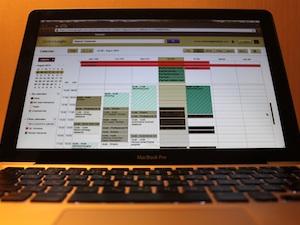Fanatical Calendar Use

As the years go by I deepen my understanding that time is the single most precious resource we humans have. Wisely invested it can produce returns of such magnitudes than no other economical resource could ever match, even money. The good thing is that we all have got exactly the same to play with: 24 hours a day, 365 days a year. This means that whether we become winners or losers in this game called life depends primarily on how we choose to spend our equal share. For this reason I’m constantly rethinking what I do with my time. The little tweaks I introduce affect all dimensions of time management from clearer life priorities setting to more efficient toolset usage. In this note, which will be the first in the series on time management, I want to share my evolution and current approach to working with the most basic time management tool of all — the calendar. I’ve decided to call my way of working with the calendar “fanatical calendar use”, to emphasize the degree of discipline which accompanies the following three simple concepts it’s based upon.
1. Time Allocation vs. Meeting Scheduling
Like most people I started working with the calendar when I began my professional career. And just like most people, initially I saw it purely as a meeting scheduling tool. Want to block someone’s time? Send them an invite. For a long time all I had on my calendar were meetings, most imposed by other people. Then, thanks to authors of numerous smart books and painful experience of fitting my own individual work in between the meetings, I’ve come to realize that the calendar was intended in the first place as a time allocation and tracking tool, not a meeting scheduling tool. As such, it should hold all the work in it, not just meetings. And this is exactly how I do it now. I have 100% of the time I spend at work accounted for on my calendar. This not only allows me to better plan my activities ahead of time, but to also have easily accessible data for backwards analysis of how I actually spend my time.
2. Scheduled vs. Unscheduled
The fact that 100% of time needs to be ultimately accounted for on the calendar doesn’t mean that we should try to plan it all out and completely fill our calendars weeks in advance. This is not effective for two reasons: 1) the reality often intervenes in our plans and throws major changes; 2) we need to make ourselves available for other people to build relationships and good will. My solution of this dilemma lies in having two separate calendar instances accordingly called “Scheduled” and “Unscheduled”. They both show in my weekly agenda view with slightly different colors. The events on the Scheduled calendar take about 60% of the time, the rest 40% is for Unscheduled.
Scheduled is the primary calendar that contains all my regular meetings (e.g. 1×1s, monthly reviews, etc.), routine activities (e.g. email processing, weekly reporting, etc.), and time allocated for personal work on top priority projects. All these slots are allocated in advance: some on perpetual recurring basis, some weeks or days ahead of time. This calendar is the only one made visible for my colleagues for considering my availability when they want to impose on my time with their meeting or call. And they can have generous 40% open for them to choose from.
Unscheduled calendar is filled on as-I-go basis. Every morning I start with reviewing my to-do list and distribute top priority items within the time slots available during that particular day by creating events on the Unscheduled calendar. Several times a day or at least once in the end of the day I look back and make sure that I actually worked my plan. If something got changed, I make respective edits post factum.
3. Reasonable Granularity of 30 Min Chunks
The activities we do during a typical working day vary in duration greatly. Some take several hours to finish. Others can be done in few minutes. If we really want to account for everything, does it mean that we should create tiny calendar events for all minutia items? No, this would be overkill. What I do is operate 30 min slots as my minimum indivisible event length. This forces me to combine my work on the small items in a single 30 min slot and then account for it with a generalized caption. For example if I reviewed a number of small deliverables from my team and provided them my feedback, this slot can be called “Feedback to the team”. In some cases, where events are very different in nature I can resort to even higher-level generalization, like “Managerial activities”, or “Research related activities”. I know that many managerial consultants would disapprove operating 30 min time-slots as minimum level of granularity, saying that many meetings can be done in less than 30 min. This is true, but in my experience I didn’t found making events smaller duration on the calendar more productive. I do finish many things in less time that I planned for them, but when it happens I simply fit a few small to-do items in the time that became available and slightly adjust the title of the event to reflect that.
Well, these are the three simple principles I currently adhere to in my calendar management. Even though I think they serve me quite well now, I will keep searching for ways to improve the system further. In the meantime, stay tuned for my next little article about two other essential tools for time management.